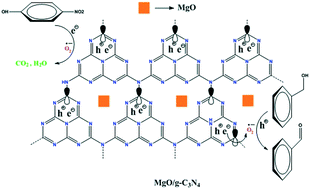当前位置:
X-MOL 学术
›
Catal. Sci. Technol.
›
论文详情
Our official English website, www.x-mol.net, welcomes your feedback! (Note: you will need to create a separate account there.)
Mechanistic insights into 4-nitrophenol degradation and benzyl alcohol oxidation pathways over MgO/g-C3N4 model catalyst systems†
Catalysis Science & Technology ( IF 5 ) Pub Date : 2018-04-20 00:00:00 , DOI: 10.1039/c8cy00431e P. V. R. K. Ramacharyulu,Sk Jahir Abbas,Smruti R. Sahoo,Shyue-Chu Ke
Catalysis Science & Technology ( IF 5 ) Pub Date : 2018-04-20 00:00:00 , DOI: 10.1039/c8cy00431e P. V. R. K. Ramacharyulu,Sk Jahir Abbas,Smruti R. Sahoo,Shyue-Chu Ke

|
A series of g-C3N4-based visible light active photocatalysts was prepared by using melamine as a precursor and MgO as a dopant. The composites exhibited excellent photocatalytic activity in the degradation of 4-nitrophenol and selective oxidation of benzyl alcohol in aqueous media under a low-power visible LED light source. The composites oxidized benzyl alcohols to benzaldehydes with better selectivity and conversion efficiency in mild acidic conditions (pH 5–6) than in neutral conditions. When compared to pure g-C3N4, the as-synthesized MgO/g-C3N4 composites showed about five-fold enhancement in photocatalytic activity. EPR spectroscopy results revealed identical EPR signals from both g-C3N4 and MgO/g-C3N4 composites, thus confirming the presence of unpaired electrons with C2p character. Introduction of MgO into g-C3N4 resulted in an increased number of electrons trapped in the C2p states of g-C3N4, which manifested as an enhancement in the EPR signal intensity. The difference in the light and dark EPR spectral signal intensities verified the efficient charge separation in the as-synthesized MgO/g-C3N4 catalysts. Moreover, the double integral values of the visible and dark EPR spectral signal difference intensities matched well with the 4-nitrophenol degradation rate constants. This further confirms the importance of trapped electrons in C2p states responsible for the observed higher photocatalytic activities. Radical scavenging experiments evidenced electrons as the dominant active species responsible for 4-nitrophenol degradation, whereas both electrons and holes were observed to participate in the selective oxidation of benzyl alcohol. Furthermore, the scavenging experiments ruled out the possibility of either hydroxyl or singlet oxygen radicals influencing the rate of oxidation. This study demonstrates MgO/g-C3N4 as a viable photoactive material for applications related to environmental pollution abatement. The photoactive nature of the catalysts in aqueous media under a low-power visible LED light source further signifies their economic and ecological aspects, which can be exploited for other applications as well.
中文翻译:

在MgO / gC 3 N 4模型催化剂体系上对4-硝基苯酚降解和苯甲醇氧化途径的机理的见解†
以三聚氰胺为前体,以MgO为掺杂剂,制备了一系列基于gC 3 N 4的可见光活性光催化剂。该复合材料在低功率可见光LED光源下,在水性介质中4-硝基苯酚的降解和苯甲醇的选择性氧化方面表现出优异的光催化活性。在中性酸性条件下(pH 5-6),该复合物将苄醇氧化为苯甲醛的选择性和转化效率比中性条件更好。与纯gC 3 N 4相比,合成后的MgO / gC 3 N 4复合材料的光催化活性提高了约五倍。EPR光谱结果表明,来自gC 3 N 4和MgO / gC 3 N 4复合材料的EPR信号相同,从而证实存在具有C 2p特征的不成对电子。将MgO引入gC 3 N 4导致陷于gC 3 N 4的C 2p状态的电子数量增加,这表现为EPR信号强度的增强。EPR亮光和暗光信号强度的差异验证了合成MgO / gC 3中有效的电荷分离N 4催化剂。而且,可见和暗EPR光谱信号差强度的双积分值与4-硝基苯酚降解速率常数很好地匹配。这进一步证实了在所观察到的较高的光催化活性中,处于C 2p态的被俘获电子的重要性。自由基清除实验证明电子是造成4-硝基苯酚降解的主要活性物质,而观察到电子和空穴都参与了苯甲醇的选择性氧化。此外,清除实验排除了羟基或单线态氧自由基影响氧化速率的可能性。这项研究表明MgO / gC 3 N 4作为与环境污染减轻相关的应用的可行的光敏材料。在低功率可见光LED光源下,水性介质中催化剂的光活性性质进一步表明了其经济性和生态性,也可用于其他应用。
更新日期:2018-04-20
中文翻译:

在MgO / gC 3 N 4模型催化剂体系上对4-硝基苯酚降解和苯甲醇氧化途径的机理的见解†
以三聚氰胺为前体,以MgO为掺杂剂,制备了一系列基于gC 3 N 4的可见光活性光催化剂。该复合材料在低功率可见光LED光源下,在水性介质中4-硝基苯酚的降解和苯甲醇的选择性氧化方面表现出优异的光催化活性。在中性酸性条件下(pH 5-6),该复合物将苄醇氧化为苯甲醛的选择性和转化效率比中性条件更好。与纯gC 3 N 4相比,合成后的MgO / gC 3 N 4复合材料的光催化活性提高了约五倍。EPR光谱结果表明,来自gC 3 N 4和MgO / gC 3 N 4复合材料的EPR信号相同,从而证实存在具有C 2p特征的不成对电子。将MgO引入gC 3 N 4导致陷于gC 3 N 4的C 2p状态的电子数量增加,这表现为EPR信号强度的增强。EPR亮光和暗光信号强度的差异验证了合成MgO / gC 3中有效的电荷分离N 4催化剂。而且,可见和暗EPR光谱信号差强度的双积分值与4-硝基苯酚降解速率常数很好地匹配。这进一步证实了在所观察到的较高的光催化活性中,处于C 2p态的被俘获电子的重要性。自由基清除实验证明电子是造成4-硝基苯酚降解的主要活性物质,而观察到电子和空穴都参与了苯甲醇的选择性氧化。此外,清除实验排除了羟基或单线态氧自由基影响氧化速率的可能性。这项研究表明MgO / gC 3 N 4作为与环境污染减轻相关的应用的可行的光敏材料。在低功率可见光LED光源下,水性介质中催化剂的光活性性质进一步表明了其经济性和生态性,也可用于其他应用。



























 京公网安备 11010802027423号
京公网安备 11010802027423号